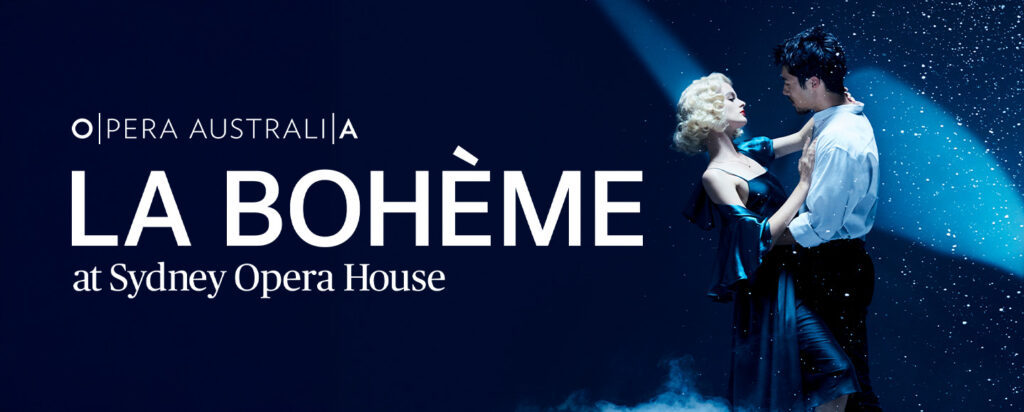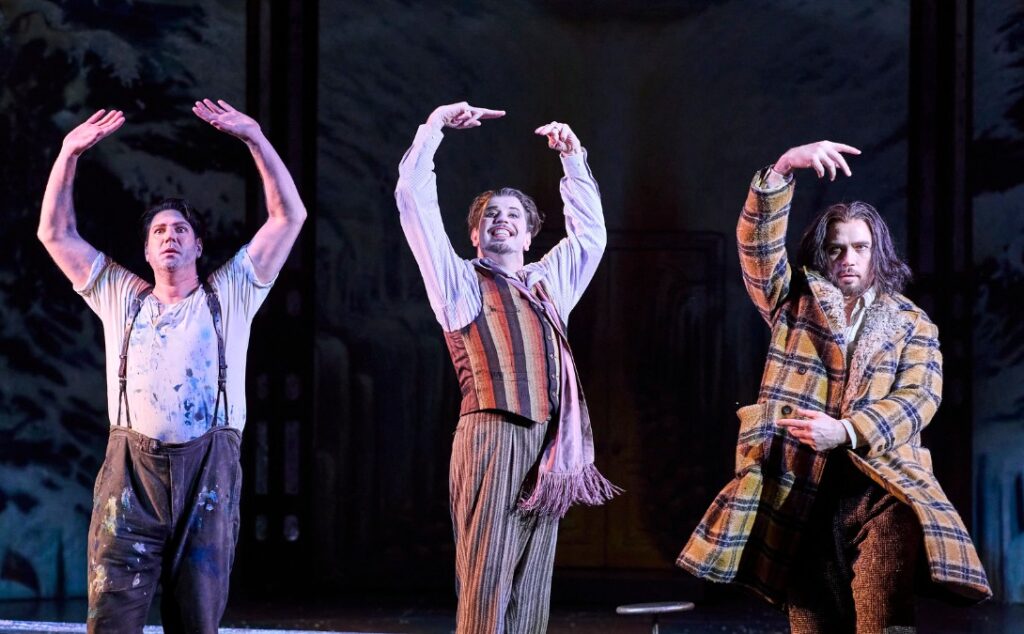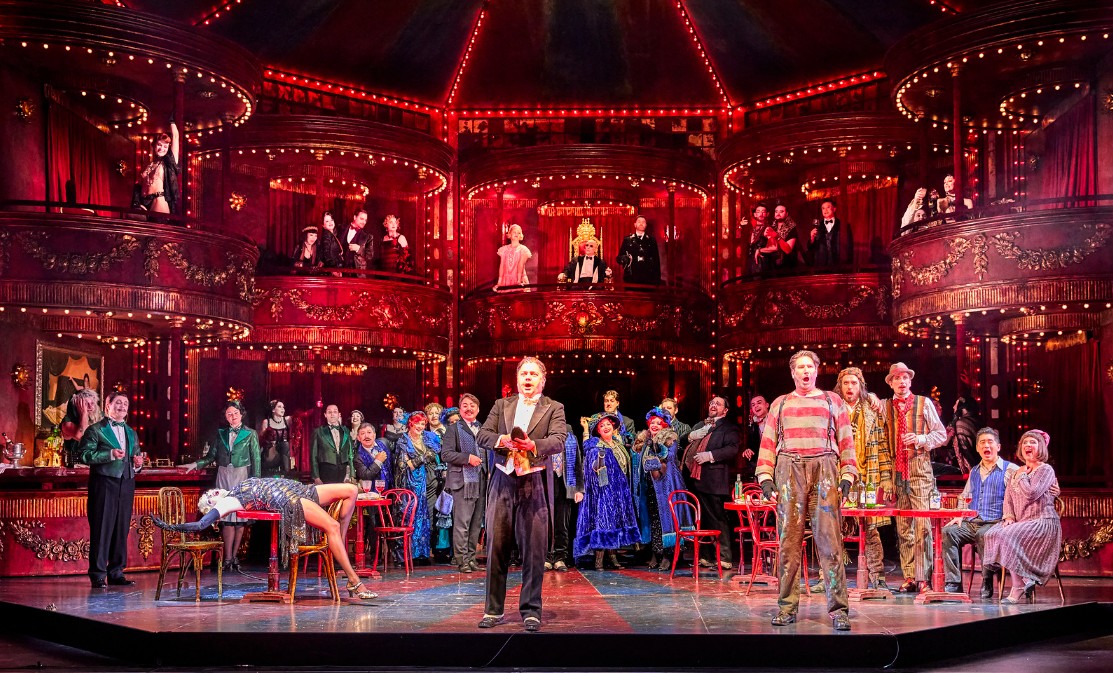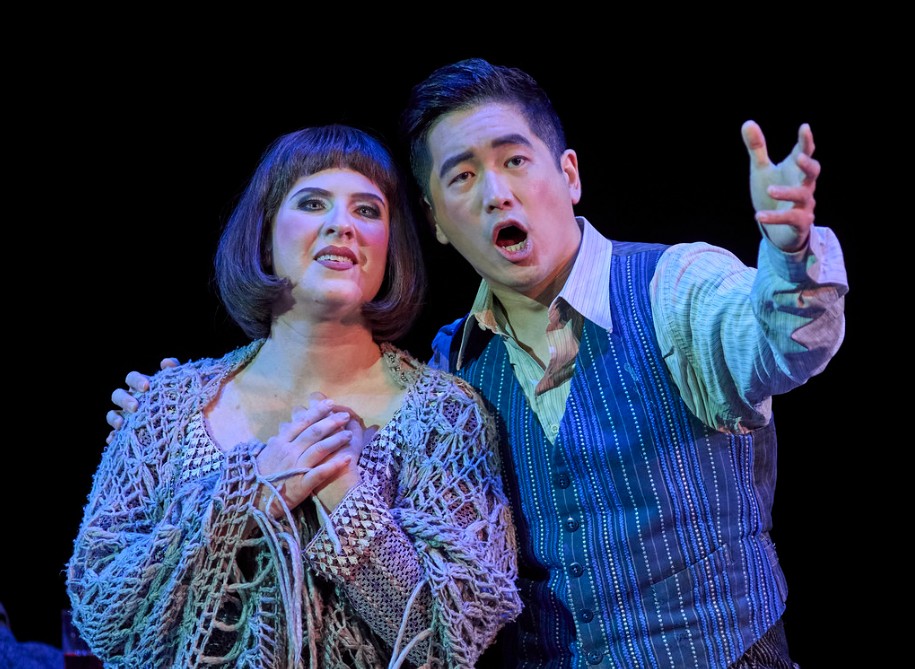
Composed by Giacomo Puccini, libretto by Luigi Illica and Giuseppe Giacosa, based on Scènes de la vie de bohème by Henri Murger
Filled with dealistic hopes and tragic realities, Puccini’s bohemian love story returns to the Opera House
Reviewed by Claira Prider
Joan Sutherland Theatre, Sydney Opera House
Until 20 September, 2025
Tickets: https://opera.org.au/productions/la-boheme-sydney/
Type: Opera, Blockbuster Opera, Italian Opera
If you liked: Tosca, La Traviata, Don Giovanni
Written in the 1890s, Giacomo Puccini’s La Bohème had its first Australian performance in Melbourne’s His Majesty’s Theatre in 1901. This production by Gale Edwards was commissioned and premiered in 2011 and has been a constant in the Opera Australia repertoire; this being its’ eleventh season in the last fourteen years. Edwards’ staging moves the setting from 1840s Latin-quarter Paris to 1930s Weimar Germany amidst times of social and political upheaval.
La Bohème follows the story of a young seamstress, Mimi, who falls in love with a writer that lives with a handful of boho-artist friends. Exploring the intensity and power of love and art, the harsh realities of 19th Century life throw the young lovers’ story into tragedy as the impact of poverty consumes Mimi – a death that could have probably been avoided with the likes of warmth and medical treatment. Puccini’s writing is known for its emotional depth in storytelling, swelling and soaring dramatic motifs as he used instruments for evocative and atmospheric effect. The score of La Bohème epitomises all of these things blending verismo realism with lyrical romanticism in this grand and poetic melodrama.

The curtain opens to a large, high ceilinged, run-down concrete building interior. This is where four housemates live: a painter, a poet, a philosopher and a musician. Puccini doesnt muck around with prologue or overture, and we’re thrown straight into the action. There’s a shabby looking guy atop rusty metal scaffolding who’s painting a huge mural on the internal walls while his housemate is so desperate for warmth he’s feeding the stove with pages of his latest writing. When the landlord arrives demanding rent, they get him drunk, trick him, and go to the pub instead. As they’re about to leave, Mimi – a struggling seamstress and their downstairs neighbour knocks on the door asking for help to find her keys that she just dropped. Rodolfo stays to help, and while searching on hands and knees in the dark, their fingers touch, and (obviously) they immediately fall madly and deeply in love. Despite being set centuries ago, it’s giving very Uni share-house (à la RENT) vibes.
The sets transport us from miserable, harsh, cold concrete greys and sparsely furnished spaces to the lavish, red velvet and gold trim and fairy lights of Café Momus. Julie Lynch’s costumes highlight the classist themes that are so prominent in the work, and the textural richness of her vision reinforces Edwards’ presentation of a society on the edge of collapse. Cabaret scenes are filled with provocative, glittering prostitute outfits, Musetta wears an unforgettable sparkling dress and is dripping in glamour. Meanwhhile in the same room, the bohemians wear drab, raggedy, mismatched clothes that are layered for warmth. John Rayment’s lighting helps to clarify the fast-moving plot, highlighting the passing of time and class systems. There’s a spectacular moment in Act III which Rayment’s lighting facilitates to create a silhouette against the falling snow, whilst the main action takes centre stage.

Kang Wang performs the role of love-stricken writer, Rodolfo. His exquisite opening aria sets a stunning standard for the evening – attracting such a long ovation it halted the flow of Act I. Wang’s voice is smooth yet radiant, engaging a masterfully chiaroscuro sound that soars over the orchestra with ease. Opposite is Olivia Cranwell performing her role debut of Mimi. Her tone is full-bodied and focused, infused with a dramatic intensity and richness that lends itself to a strikingly gutsy portrayal of Mimi. While compelling, her characterisation and vocal performance does feel at odds with the delicate vulnerability typically associated with Mimi.
On opening night, the lovers feel lacking in chemistry and somewhat soloistic. Their performance of ‘O soave fanciulla’ matches the romantic intensity of the score but lacks dynamic shape and sensitivity that really makes this duet so special. This is particularly noticeable in the decrescendoing parallel octaves in the closing bars of Act I. The cohesion between orchestra and cast on opening night felt unstable and disconnected, however, conductor Erina Yashima is extremely responsive to the action on stage while continuing to drive the busily unfolding plot.
…a dazzling, exciting and affecting production that reminds us why La Bohème is one of the most well loved operas of the western world
Luke Gabbedy performs the role of Marcello, the on-and-off-again lover to Musetta. His committed performance beautifully highlights the character’s inner conflict, deep devotion to his friends and fiery, passionate lust. Rachelle Durkin‘s Musetta is fun and vivacious; the characterisation matches her vibrant, sparkling light tone that shines so effortlessly in ‘Quando me’n vo’. Her tabletop dancing comes across as more funny and flapper-esque than seductive, but it works well and feels better suited to her more compassionate and emotionally complex character interpretation.
Shane Lowrencev performs the role of Schaunard (for the 9th time with Opera Australia) and injects a camp flair and vibrancy into the role. David Parkin gives a generous and powerful performance as Colline, particularly moving in his ‘Goodbye Coat’ aria. All veterans to the roles, the penniless housemates take a while to gel, but warm into familiar and cosy chemistry as they survive together on friendship, camaraderie and love of art. Andrew Moran is pompous and engaging as Benoit before portraying the aristocratic and older admirer Alcindoro – his interpretation and vocal versatility matches his concise comedic timing.
In a time when we’re watching the denial of humanitarian aid and healthcare to the most vulnerable, Edwards production is particularly poignant. The cabaret club scene where the hookers are sidling up to aristocrats in Gestapo-esque uniforms overlooking the crowd below sent shivers down my spine, and the Checkpoint Charlie-esque setting of Act III with the constant sense of surveillance hit a lot closer in comparison to other productions. While extremely well worn, (so well worn that the doors to the attic house kept falling open) this is a dazzling, exciting and affecting production that reminds us why La Bohème is one of the most well loved operas of the western world.
Fun Theatre Fact: Baz Luhrman directed a production of La Bohème at the Sydney Opera House in 1990 before releasing Moulin Rouge! which was very much inspired by Mimi and Rodolfo’s story

Conductor Erina Yashima (23 Aug–16 Sep) & Paul Fitzsimon (18 & 20 Sep)
Director Gale Edwards
Costume Designer Julie Lynch
Lighting Designer John Rayment
Revival Director Danielle Maas
Mimì Olivia Cranwell
Rodolfo Kang Wang (23 Aug–16 Sep) Iain Henderson (18 & 20 Sep)
Musetta Rachelle Durkin
Marcello Luke Gabbedy
Schaunard Shane Lowrencev
Colline David Parkin
Benoit/Alcindoro Andrew Moran
Officer Clifford Plumpton
Sergeant Malcolm Ede
Parpignol Benjamin Rasheed
Opera Australia Orchestra
Opera Australia Chorus





